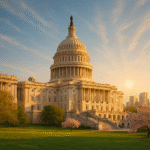Key Takeaways
- Japan’s $550 billion investment package, linked to a U.S. tariff agreement, targets strategic sectors including semiconductors, shipbuilding, and critical minerals.
- The agreement allows Japan to maintain U.S. market access while investing in American industrial infrastructure as part of a reciprocal tariff arrangement.
- Semiconductor investments may support Taiwanese manufacturers establishing production in the U.S., reducing reliance on high-risk supply chains.
- Shipbuilding funds aim to revitalise declining U.S. production capacity, potentially creating tens of thousands of skilled jobs.
- Despite the lack of binding specifics, the deal is seen as a strategic manoeuvre to realign economic partnerships and isolate China from key supply networks.
Japan’s announcement of a $550 billion investment package tied to a recent US tariff agreement marks a pivotal shift in global trade dynamics, channeling substantial funds into strategic sectors like semiconductor manufacturing and shipbuilding. This deal not only averts steeper tariffs but also positions both nations to bolster supply chain resilience amid escalating geopolitical tensions, potentially reshaping industrial landscapes across the Pacific.
The Structure of the Deal
At its core, the agreement involves Japan committing $550 billion in investments and loans directed towards revitalising key US industries. According to reports from Reuters and the White House, these funds are earmarked for areas including energy infrastructure, semiconductor production, critical minerals, pharmaceuticals, and shipbuilding. This comes in exchange for reciprocal tariffs set at 15%, allowing Japan to maintain access to the US market while opening its own to American goods such as automobiles and agricultural products.
The scale is staggering—equivalent to nearly 14% of Japan’s 2024 GDP—and builds on Japan’s existing status as the largest foreign direct investor in the US, with cumulative investments reaching $754 billion by last year. Unlike traditional foreign investments driven by profit motives, this package is framed as a strategic partnership, with funds potentially financing projects that enhance mutual security interests.
Focus on Semiconductors
Semiconductors represent a cornerstone of the investment strategy, addressing vulnerabilities in global supply chains. The US has long relied on Taiwanese firms for advanced chip production, a dependency highlighted by proximity to China and associated risks. Under this deal, Japanese funds could support Taiwanese semiconductor manufacturers in establishing US-based facilities, leveraging Japanese technology and components.
Japan’s top trade negotiator has indicated that the package might finance such initiatives, aligning with broader efforts to diversify away from concentrated production hubs. Analyst sentiment from Bank of America suggests this could serve as a blueprint for similar deals with other nations, like South Korea, emphasising onshoring of critical technologies. Forecasts from industry models project that bolstering US semiconductor capacity could add up to 200,000 jobs over the next decade, though execution hinges on navigating regulatory and logistical hurdles.
- Potential for shared profits based on contributions, as per Japanese government statements.
- Integration of Japanese supply chains to mitigate risks from geopolitical flashpoints.
- Alignment with US initiatives like the CHIPS Act, which has already allocated billions for domestic fabrication.
Shipbuilding and Broader Strategic Industries
Shipbuilding emerges as another focal point, with investments aimed at modernising US yards and expanding capacity in areas like LNG carriers and icebreakers. This move seeks to rebuild industrial capabilities outside of China, where dominance in ship construction has raised concerns over global trade dependencies.
Historical context underscores the urgency: US shipbuilding output has declined significantly since the 1980s, while China’s share has ballooned to over 50% of global production. The Japanese infusion could reverse this trend, directing funds towards infrastructure upgrades and workforce training. Analyst-led projections estimate that revitalising this sector might generate tens of thousands of high-skilled jobs, contributing to a more balanced trade ecosystem.
Beyond ships and chips, the package extends to critical minerals and pharmaceuticals, sectors vital for national security. For instance, investments in American-mined minerals could reduce reliance on foreign supplies, echoing multi-year trends where supply disruptions have spiked prices by as much as 300% in volatile periods.
Economic Implications and Risks
From an investor perspective, this deal signals opportunities in targeted industries. Semiconductor firms with US expansion plans may see accelerated growth, while shipbuilding companies could benefit from subsidised projects. However, the agreement’s vagueness—lacking a fully binding written framework, as noted in reports from The New York Times and Axios—introduces uncertainty. Japanese officials have emphasised that investments will proceed only if they yield mutual benefits, with profits shared proportionally.
Market sentiment, as gauged by credible sources like the Financial Times, remains cautiously optimistic, with some viewing it as “vaporware” due to undefined terms. Yet, the strategic intent is clear: isolating China by fortifying allied supply chains. If fully realised, this could enhance long-term economic stability, though short-term volatility in related stocks might persist amid negotiation details.
| Sector | Projected Investment Focus | Potential Impact |
|---|---|---|
| Semiconductors | Financing US plants with Taiwanese and Japanese tech | Job creation: 100,000+; Reduced geopolitical risk |
| Shipbuilding | Modernisation of US yards for LNG and icebreakers | Industrial revival; Enhanced energy security |
| Critical Minerals | Domestic mining and processing | Supply chain diversification; Price stability |
| Pharmaceuticals | US-based manufacturing expansion | Health security; Reduced import dependency |
Critics argue the deal’s scale invites scrutiny, with $550 billion dwarfing previous bilateral commitments. Dry humour aside, it’s as if Japan is buying tariff insurance with a premium that could fund an industrial renaissance—or fizzle into diplomatic footnotes if commitments waver.
Global Ripple Effects
Looking ahead, this pact could influence trade negotiations worldwide. Countries exporting to the US might adopt similar investment-for-tariff models, particularly in autos and tech. For investors, monitoring joint forums—set to launch soon for overseeing these projects—will be key. Analyst models from firms like Bank of America forecast that successful implementation could boost US GDP growth by 0.5% annually over five years, though this assumes seamless execution.
In summary, Japan’s $550 billion package under the US tariff deal represents a bold gambit in strategic economic alignment. By targeting semiconductors, shipbuilding, and beyond, it aims to forge resilient industries, but success will depend on translating pledges into tangible projects. Investors should watch for clarity on profit-sharing and project timelines, as these will dictate the deal’s true value.
References
- Axios. (2025, July 24). Japan trade deal and Trump tariffs. Retrieved from https://www.axios.com/2025/07/24/japan-trade-deal-trump-tariffs
- Digitimes. (2025, August 14). Japan-USA government investment. Retrieved from https://digitimes.com/news/a20250814VL204/japan-usa-government-investment-2025.html
- Fortune. (2025, July 26). US-Japan trade deal and $550 billion investment vehicle. Retrieved from https://fortune.com/2025/07/26/us-japan-trade-deal-trump-tariffs-550-billion-investment-vehicle/
- Institute for Energy Research. Trump reaches trade deal with Japan. Retrieved from https://www.instituteforenergyresearch.org/international-issues/trump-reaches-trade-deal-with-japan/
- Japan News. (2025, August 6). Politics & Government. Retrieved from https://japannews.yomiuri.co.jp/politics/politics-government/20250806-274083
- New York Times. (2025, July 31). Trump, Japan, and South Korea investment. Retrieved from https://www.nytimes.com/2025/07/31/business/trump-japan-south-korea-investment.html
- Reuters. (2025, July 26). Japan’s $550 billion package and Taiwanese chipmaker in US. Retrieved from https://www.reuters.com/world/asia-pacific/japan-says-550-billion-package-trade-deal-could-finance-taiwanese-chipmaker-us-2025-07-26/
- Reuters. (2025, July 25). Japan says profits in US investments under trade deal will be shared by contributions. Retrieved from https://www.reuters.com/business/finance/japan-says-profits-us-investments-trade-deal-be-shared-according-contributions-2025-07-25/
- Reuters. (2025, August 6). Japan says US investments under trade deal to be determined by benefits. Retrieved from https://www.reuters.com/business/autos-transportation/japan-says-us-investments-under-trade-deal-will-be-determined-by-benefits-tokyo-2025-08-06/
- TradingView. Japan’s $550B investment could back Taiwan chip plants in US. Retrieved from https://www.tradingview.com/news/invezz:07bd666f2094b:0-japan-s-550b-investment-could-back-taiwan-chip-plants-in-us-says-trade-official/
- White House. (2025, July). Fact Sheet: President Donald J. Trump secures unprecedented U.S.–Japan Strategic Trade and Investment Agreement. Retrieved from https://www.whitehouse.gov/fact-sheets/2025/07/fact-sheet-president-donald-j-trump-secures-unprecedented-u-s-japan-strategic-trade-and-investment-agreement/
- Yahoo Finance. Japan says $550 billion package backs tariff deal. Retrieved from https://finance.yahoo.com/news/japan-says-550-billion-package-152633132.html














